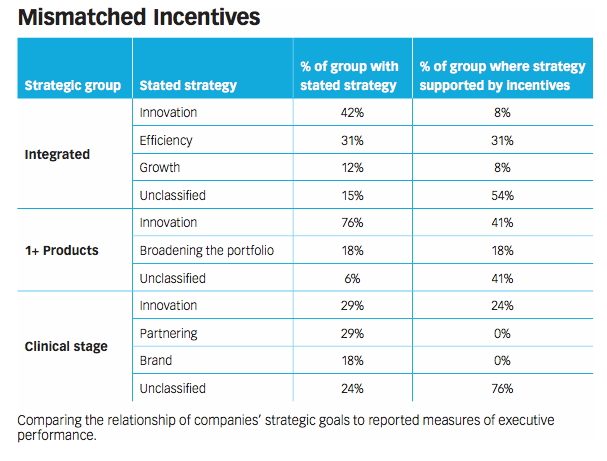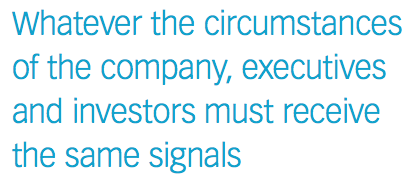Executive Pay and Innovation
Pharmaceutical Executive
How the need for biopharma innovation extends to questions around executive compensation.
With pharma executive compensation under increased scrutiny, this analysis explores the alignment of company innovation incentives and long-term strategic goals
Executive compensation is under intense scrutiny. Part of the discussion has focused on how much executives are paid and who should decide the amount. In the UK, for example, “say-on-pay” rules attempt to ensure that rewards reflect the best interests of shareholders. Another part of the discussion involves the form compensation should take; boards in recent years have decreased the use of stock options while placing greater emphasis on long-term value creation, using metrics such as TSR (total shareholder return) and ROIC (return on invested capital). These efforts have allayed some of the concerns of shareholders and the broader public by increasing pay transparency and the likelihood that boards’ and managers’ interests are aligned.
But the current conversation about executive pay tends to obscure a critical question, one that’s especially pressing in biopharma: whether the yardsticks by which executives are rewarded reflect and advance a company’s stated strategy.
The challenge for boards
As boards consider their strategic goals, then, they need to consider: What do they reward and why? Are they encouraging only the pursuit of short-term profits or also sustainable, long-term innovation? In biopharma, where the often decades-long process of drug development exceeds the quarterly rhythms by which the market measures value, these questions come into particularly sharp focus because innovation takes so much time and money. According to the Tufts Center for the Study of Drug Development, the cost of developing a new drug is $1.2 billion to $2.6 billion out of pocket and $1.4 billion in returns that investors forgo over the decade or more that a therapy is in development. Meanwhile, public and private payers around the world are questioning the sustainability of what are perceived to be high drug prices.
Given these realities, boards must balance the need to create sustainable cash flow to fund ongoing R&D with the need to meet institutional investors’ demands for competitive returns. Boards must also send the same signals to executives and managers about the priority of innovation. For example, if boards say innovation is a priority but actually reward only for returns, then executives and managers will act to produce returns. Although investors may be pleased with the numbers in the near term, they’ll eventually wonder why the new drugs aren’t appearing.
Therefore, for boards, practical questions arise:
- What are the available strategic options to maximize innovation?
- How should they structure executive compensation?
- How, under pressure from shareholders for regular returns, can boards ensure that the executive leadership team stays focused on long-term development goals?
- How can they devise incentives that reflect the time horizons of drug development?
The innovation gap in compensation
Some would argue that the first duty of companies, even those in the life sciences, is to maximize shareholder value-that the only appropriate incentives are those that maximize profit, and that, therefore, the question of long-term incentives is incidental. We believe, however, that such a view is in the long-term interests neither of investors nor of the life sciences industry as a whole. The duty is to all shareholders, and profit maximization must focus on the quality of the profits. To ensure long-term innovation-and long-term profitability-the life sciences industry must devise award packages appropriate to the time horizon of product development.
So, we asked: Are innovation goals adequately reflected in the way biopharma executives are compensated? We began by comparing companies’ stated strategic goals to reported measures of executive performance. For example, if a company declared innovation as a strategic goal, we assessed the extent to which the goal was matched by incentives. We looked at companies ranging from clinical-stage entities to big pharma. We divided life sciences companies into three groups: pipeline companies, companies with one or more assets (“1+ companies”), and large, fully integrated companies. We then classified their strategies as focused on innovation, efficiency or growth. We compared the stated focus to performance measures as reported in publicly available documents.
What we found
Where the strategy was efficiency, incentives were well-matched to the goal. Where the focus was innovation, however, we found a mismatch between stated strategies and incentives.
The table below provides more detail. The first, far-left column names types of companies (integrated, 1+ products, and clinical stage). The second column indicates stated strategy within each strategic group. The third column shows the percentage of companies within each group that follow a stated strategy. For example, among integrated companies, 42% declare a strategy of innovation.
The last column shows the percentage of companies in each group whose incentives reflect stated strategy. For example, 8% of integrated companies whose strategy is innovation support that strategy with appropriate incentives. Which is to say, 8% of the 42% of integrated companies that pursue an innovation strategy back it up with incentives.

What do these figures tell us? For one thing, we see that fully integrated companies are much more successful at incentivizing efficiency than innovation or growth; when it comes to efficiency, word and deed come close to matching. Innovation presents a different story. While over 40% of integrated companies tout their innovation bona fides, only 8% of those who declare such a focus back their words with incentive plans.
The picture for innovation is somewhat brighter among companies with one or more products. Fully three quarters state innovation as a strategy, and over 40% of those companies have compensation schemes that reflect their strategic intentions. For the last group, clinical stage companies, about a quarter of those that proclaim innovation have incentives to match. Also striking is the fact that brand and partnering strategies have no incentives explicitly backing them up.
To give more dimension to the nature of the support each group gives, we can look at how strongly groups support each strategy. The chart below shows the extent to which, for each strategy, incentives are focused. The chart is divided into three groups of bars representing the classifications we studied (from left to right: fully integrated, 1+ and clinical). Each bar represents a strategy within that group that a cluster of companies pursues. The colors represent each cluster’s degree of focus. We judge that a company has:
- A “strong focus” on a strategy if at least 50% of performance targets for both long-term and short-term incentives referred back to that strategy.
- “Focused” if metrics for one type of performance targets had reference to the strategy in question.
- “Some focus” as long as performance targets made any reference to the strategy.
- “No focus” if there were no performance targets attached to the strategy.

As is evident in the left three bars, nearly 90% of integrated companies successfully focus executive performance targets on efficiency, but the link between strategy and performance loosens when it comes to innovation, with over 80% of the group showing only “some focus” on it. In the middle bars, we see nearly all 1+ companies achieving focus when it comes to broadening the portfolio. As a group, they struggle to focus incentives on innovation. The third group, the clinical stage companies, shows almost 70% of companies with a strong focus on innovation.
Implications
Our analysis can be taken further, of course, but it raises an important question. Why the mismatch between stated goals and incentives? It may be that some companies lack the tactical wherewithal to create incentives to reward innovation. But a more likely explanation is that as companies grow, size eclipses focus. The larger the company, the more diffuse the strategy. Size and scale beget strategic fragmentation. A large company has ancillary services that a clinical-stage company doesn’t have: a sales

and marketing apparatus, finance, procurement and so on.
These areas require resources, and sustaining the company-feeding the beast-becomes a primary goal. Though an understandable consequence of growth, companies, as they grow, tend to become driven by efficiency rather than innovation. A story less salacious than a tale of “say one thing, do another.” But a truer one more likely.
Whatever the circumstances of the company, however, executives and investors must receive the same signals. In other words, business strategy and executive incentives must drive to the same goals. Because the timelines of drug development conflict with those traditionally used to measure business performance, life sciences boards must be thoughtful and creative when designing incentive plans. If the mission includes innovation, strategies must keep executives focused on long-term development goals.
In the end, it’s the job of boards to ensure that incentives are aligned with long-term strategy. Otherwise, investors-not to mention patients and the broader public-stand to be disappointed over the long haul.
Carl Sjostrom is a Senior Advisor at Viti Solutions. He can be reached at carl@vitisolutions.com Ian Wilcox is a Managing Partner at Cogitari Advisors, LLC. He can be reached at ian@cogitariadvisors.com

Applying Porter’s Five Forces to Portfolio Management in Pharmaceutical R&D: A Strategic Roadmap
March 17th 2025The increasing costs and complexity of R&D in the pharmaceutical industry have necessitated the adoption of strategic portfolio management to optimize resource allocation and enhance competitive advantage.
Cell and Gene Therapy Check-in 2024
January 18th 2024Fran Gregory, VP of Emerging Therapies, Cardinal Health discusses her career, how both CAR-T therapies and personalization have been gaining momentum and what kind of progress we expect to see from them, some of the biggest hurdles facing their section of the industry, the importance of patient advocacy and so much more.